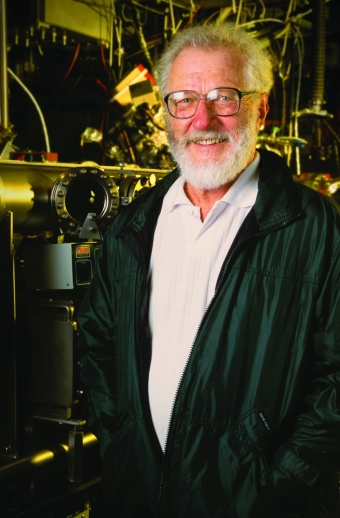
A beloved campus colleague and one of the greatest technological visionaries of our time is gone. UC Santa Barbara emeritus professor Herb Kroemer, who earned a Nobel Prize for his seminal work on compound semiconductors, died March 8, at the age of 95.
Born August 25, 1928, in Weimar, Germany, Professor Kroemer received a PhD in theoretical physics from Georg August University in Göttingen, Germany, in 1952, writing his dissertation on so-called hot-electron effects in the then-new transistor. That research set the stage for a career in research focused on the physics and technology of semiconductors and semiconductor devices.
Following work in several research laboratories in Germany and the United States, Kroemer came to UCSB in 1976, where he held the Donald W. Whittier Chair in Electrical Engineering, and was jointly appointed in the Materials Department and the Electrical and Computer Engineering Department.
Upon his arrival at UCSB, Kroemer persuaded the Electrical & Computer Engineering Department to direct a substantial portion of its limited resources to expanding the department’s small semiconductor research program, with a particular focus on the emerging field of compound semiconductor technology. Seeing an opportunity for UCSB to become a leading institution in that area, Kroemer himself became the first member of what would become one of the world’s preeminent groups dedicated to the physics and technology of compound semiconductors and the many devices they enable. This group would later include a range of preeminent Materials faculty, such as Professor Art Gossard and Professor Shuji Nakamura. Indeed, Nakamura, also a Nobel Laureate, notes “"Herb made numerous fundamental, long-lasting contributions. His concept of the heterostructure for optical devices helped me to invent the blue LED and solid-state lighting."
Kroemer became one of the early pioneers in molecular beam epitaxy (MBE), concentrating from the outset on applying the technology to new materials systems. His work provided a great stimulus toward technological development His discoveries provided the basis for numerous technological innovations we now use on a daily basis – from cell phone and satellite communications, to high-speed transistors and solid-state lighting. Since the late 1990s, Kroemer reverted to purely theoretical work, some of which continued earlier work and some in newer research areas, such as electromagnetic wave propagation in photonic crystals and the physics of nanostructures.
In addition to his research accomplishments, Kroemer was an extraordinary educator. Professor Chris van de Walle, who is the Herbert Kroemer Endowed Chair in Materials Science, notes “Herb excelled as a teacher, as exemplified by his textbooks on Thermal Physics and Quantum Mechanics for Engineering. Countless students benefited from his mentorship; many credit their success in science to the passion that Herb instilled in them.”
Kroemer received the Nobel Prize in Physics in 2000, with the citation reading “for developing semiconductor heterostructures used in high-speed- and opto-electronics.” This award can ultimately be traced to his early papers at UCSB. In addition to the Nobel Prize, Kroemer received numerous national and international honors and awards, including the 2002 IEEE Medal of Honor "for contributions to high-frequency transistors and hot-electron devices, especially heterostructure devices from heterostructure bipolar transistors to lasers, and their molecular beam epitaxy technology." In 2001, he received the Grand Cross of the Order of Merit of the Federal Republic of Germany, the highest award given by the German government. He was a member of both the National Academy of Engineering and the National Academy of Sciences, and a fellow of the American Physical Society and the Institute of Electrical and Electronics Engineers.



